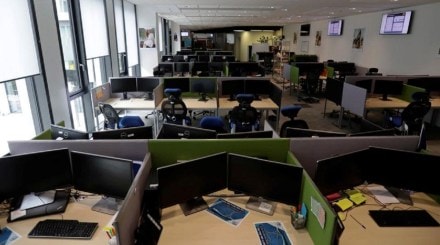– By Sudhir Thorat
As normalcy begins to return in the post-pandemic world, the future of office design is more fluid than ever. From flexible workplaces to offices with social spaces, here’s what we can expect in the offices of the future. Covid challenged the concept of the traditional office work environment. Some companies have achieved complete flexibility; others are experimenting with hybrid solutions; whilst others are reconsidering workplace layouts to meet post-pandemic safety demands. The pandemic has caused many businesses to reevaluate their office space needs and has accelerated the trend toward more flexible working arrangements. Today’s emphasis on sustainability, combined with a desire to cut travel time, may lead more and more businesses to relocate to the suburbs.
The focus for companies has now shifted to the overall well-being of the workforce. The design structures with sealed glass and steel will now become redundant. Office buildings will have to incorporate greener spaces and more open areas. Commercial real estate developers are working towards fewer touch points and better air circulation to improve the air quality in offices. The corporate sector is now waking up to the importance of creating a touchless workplace environment to make people comfortable coming back to physical offices.
Touchless elevators with the view to use lesser hands-on public surfaces leading to the spread of infection will be a must-have feature in new-age offices. They offer added flexibility and ease of use, work seamlessly with technology, and are safe and secure. Multiple ideas can be implemented to make offices more contactless, older characteristics will be replaced by new technologies that are designed to make the physical office more secure for its employees. RFID cards are another example of a characteristic that future offices can do away with. Everyone has a smartphone today, which can be used for bridging the digital and real worlds through IoT. The use of renewable energy will certainly be beneficial for upcoming office buildings. Future workplaces will need to identify the most effective ways to heat and cool buildings and to create comfortable work environments without increasing carbon emissions, as heating and air conditioning systems are one of the greatest energy users in modern structures.
Covid has made numerous changes to the design of office structures. The future office will be more human centric and high tech, they will have Zoom rooms, desk sign-up tools, occupancy automation and health-focused accents. Offices will be reconfigured as community centres with collaboration and breakout areas, rather than rows of desks. Natural lighting, greenery, gaming zones, nap rooms, mothers room and more such facilities will take centre stage. After being locked up in their homes and working from home, many employees are seeing offices as an incredible perk. For many people, an office provides a much better working environment than their home office. It provides a professional setting in which they can be more productive than at home, socialize with co-workers, and build a sense of belonging. Companies need to tap into these sentiments and work towards creating an office environment that fosters a strong sense of ownership of the workplace amongst their employees. Many companies internationally have chucked the corporate office rulebook in the bin and opted for a more social office setup where everyone can work together in an informal and friendly environment. Because of the success of the WFA (Work from Anywhere) concept in some businesses, the office space in modern times needs to be travel-worthy for the employees.
In a post-pandemic society, valuing health and wellness will not be limited to entertaining and cool organizations. Implementing health and wellness programs will become a standard norm that will benefit the employees and the company as a whole. Workplace wellness initiatives, mindfulness workshops, and allowing infants in the workplace where the mother can attend the baby and nourish timely are all excellent ways to reduce stress and promote a healthy work environment.
Smart buildings seem to be the future—buildings that are customizable to staff needs. A step forward to open-plan offices, the employee experience needs to be the focus with personalised business considerations in the planning and design of the workplaces of the future. The transparency and organic movement at work will help teams accomplish their absolute best. Going forward, businesses need to take into account several factors before buying and creating office spaces. With changing employee needs, structures will need to be encouraging to maximize the workforce’s strengths and well-being.
(Sudhir Thorat is the managing director at APICES Studio Pvt Ltd. Views expressed are the author’s own.)
